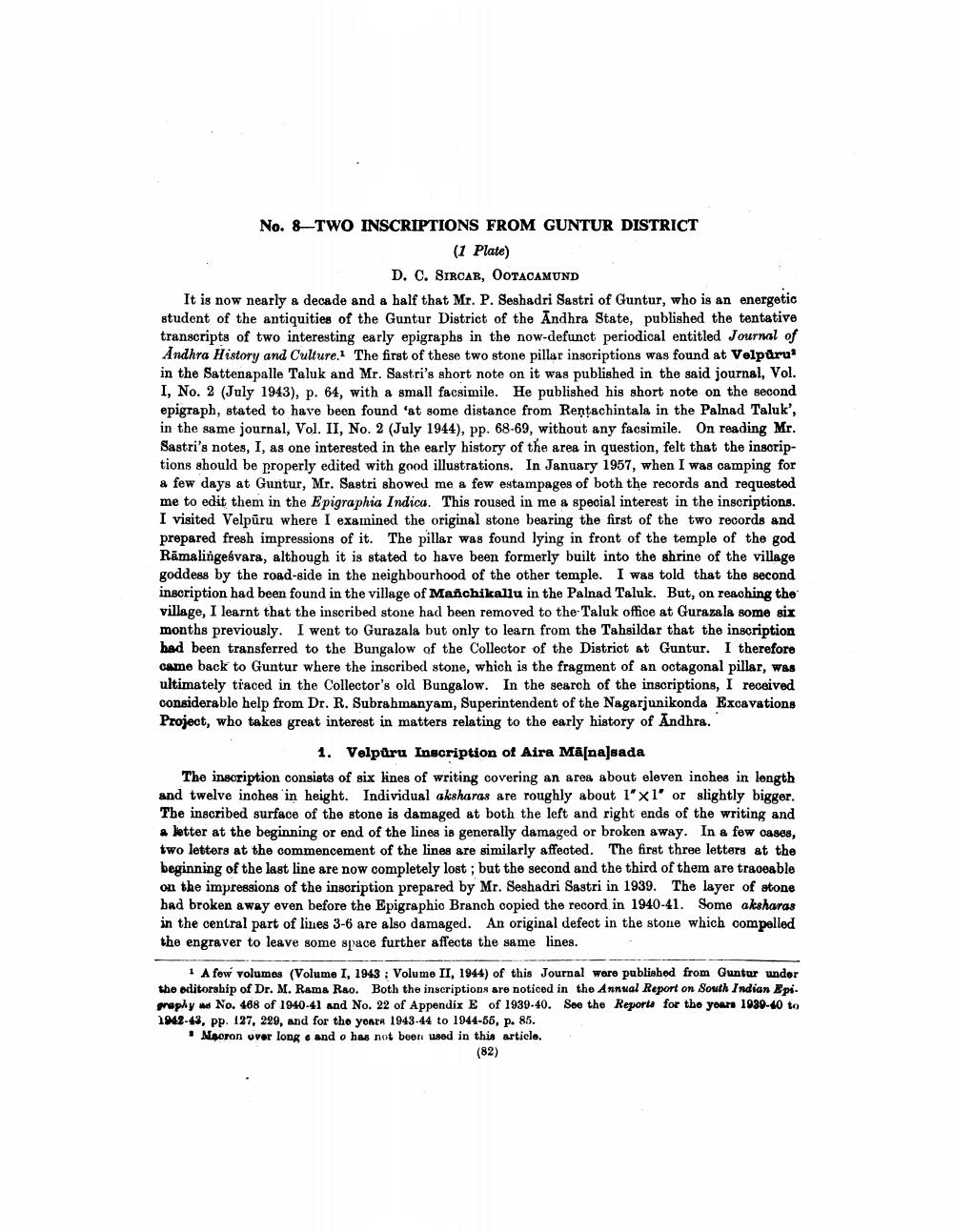________________
No. 8–TWO INSCRIPTIONS FROM GUNTUR DISTRICT
(1 Plate)
D. C. SIRCAR, OOTACAMUND It is now nearly a decade and a half that Mr. P. Seshadri Sastri of Guntur, who is an energetic student of the antiquities of the Guntur District of the Andhra State, published the tentative transcripts of two interesting early epigraphs in the now-defunct periodical entitled Journal of Andhra History and Culture. The first of these two stone pillar inscriptions was found at Velpůru in the Sattenapalle Taluk and Mr. Sastri's short note on it was published in the said journal, Vol. I, No. 2 (July 1943), p. 64, with a small facsimile. He published his short note on the second epigraph, stated to have been found 'at some distance from Rentachintala in the Palnad Taluk', in the same journal, Vol. II, No. 2 (July 1944), pp. 68-69, without any facsimile. On reading Mr. Sastri's notes, I, as one interested in the early history of the area in question, felt that the inscriptions should be properly edited with good illustrations. In January 1957, when I was camping for a few days at Guntur, Mr. Sastri showed me a few estampages of both the records and requested me to edit them in the Epigraphia Indica. This roused in me a special interest in the inscriptions. I visited Velpūru where I examined the original stone bearing the first of the two records and prepared fresh impressions of it. The pillar was found lying in front of the temple of the god Rāmalingesvara, although it is stated to have been formerly built into the shrine of the village goddess by the road-side in the neighbourhood of the other temple. I was told that the second inscription had been found in the village of Mañchikallu in the Palnad Taluk. But, on reaching the village, I learnt that the inscribed stone had been removed to the Taluk office at Gurazala some six months previously. I went to Gurazala but only to learn from the Tahsildar that the inscription had been transferred to the Bungalow of the Collector of the District at Guntur. I therefore came back to Guntur where the inscribed stone, which is the fragment of an octagonal pillar, was ultimately traced in the Collector's old Bungalow. In the search of the inscriptions, I received considerable help from Dr. R. Subrahmanyam, Superintendent of the Nagarjunikonda Excavations Project, who takes great interest in matters relating to the early history of Andhra.
1. Velpūru Inscription of Aira Mā[na]sada The inscription consists of six lines of writing covering an area about eleven inches in length and twelve inches in height. Individual aksharas are roughly about 1"X1" or slightly bigger. The inscribed surface of the stone is damaged at both the left and right ends of the writing and a better at the beginning or end of the lines is generally damaged or broken away. In a few cases, two letters at the commencement of the lines are similarly affected. The first three letters at the beginning of the last line are now completely lost; but the second and the third of them are traceable on the impressions of the inscription prepared by Mr. Seshadri Sastri in 1939. The layer of stone bad broken away even before the Epigraphic Branch copied the record in 1940-41. Some aksharas in the central part of lines 3-6 are also damaged. An original defect in the stone which compelled the engraver to leave some space further affects the same lines.
1 A few volumes (Volume I, 1943; Volume II, 1944) of this Journal were published from Guntur undor the editorship of Dr. M. Rama Rao. Both the inscriptions are noticed in the Annual Report on South Indian Epi. graphy w No. 468 of 1940-41 and No. 22 of Appendix E of 1939-40. See the Reports for the year 1989-40 to 1942-43, pp. 127, 229, and for the years 1943-44 to 1944-55, p. 85. Nooron uver long and o has not been used in this article.
(82)




